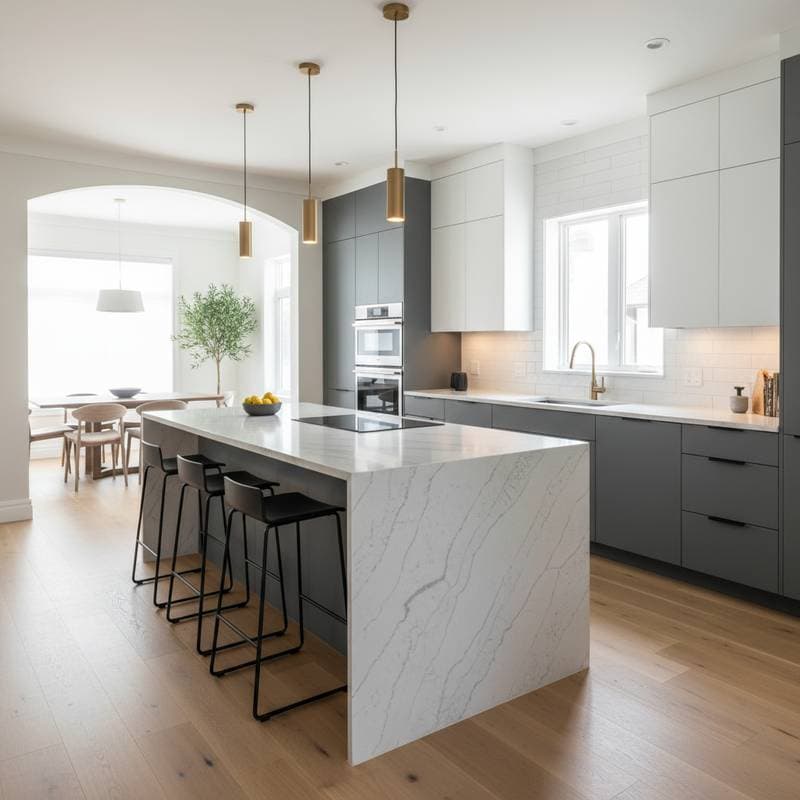Top Kitchen Upgrades That Deliver Strong Returns in 2025
Homeowners preparing to sell in 2025 focus on kitchen improvements that enhance functionality, aesthetics, and energy efficiency. Buyers prioritize spaces that combine modern convenience with timeless appeal. This guide highlights key upgrades, including quartz countertops, energy-efficient appliances, smart lighting, refinished cabinets, and semi-open layouts. Each option balances cost with potential return on investment, ensuring projects appeal to discerning buyers while supporting sustainable living.
Quartz Countertops: Durability Meets Elegance
Quartz countertops remain a top choice for their resistance to stains, scratches, and heat. Unlike natural stone, quartz requires minimal maintenance and offers a wide range of colors and patterns to suit various design styles. Installation costs range from $50 to $120 per square foot, depending on edge treatments and slab thickness.
For a standard 40-square-foot kitchen, expect to invest $2,000 to $4,800. This upgrade recoups 70 to 85 percent of costs at resale, as buyers value the low-upkeep surface that withstands daily use. Pair quartz with complementary backsplashes to create a cohesive look that elevates the entire space.
Energy-Efficient Appliances: Functionality and Savings
Buyers seek appliances that reduce energy consumption without sacrificing performance. Opt for Energy Star-rated refrigerators, dishwashers, and ovens, which use up to 50 percent less electricity than older models. Induction cooktops provide precise heating and faster cooking times, appealing to home chefs.
Budget $3,000 to $7,000 for a full set of mid-range appliances. These investments yield 60 to 75 percent ROI through lower utility bills and buyer incentives for eco-friendly features. Select stainless steel finishes for a sleek, professional appearance that integrates seamlessly with other elements.
Smart Lighting: Convenience and Ambiance
Smart lighting systems allow voice or app control, dimming, and scheduling to match daily routines. LED bulbs integrated into under-cabinet strips or recessed fixtures provide even illumination for food preparation and entertaining. Initial setup costs $500 to $1,500, including hubs and compatible bulbs.
This upgrade recovers 65 to 80 percent of expenses by modernizing the kitchen and reducing energy use by 75 percent compared to incandescent options. Install motion sensors in pantries or islands to enhance usability, creating a welcoming atmosphere that impresses during showings.
Refinished Cabinets: Refresh Without Replacement
Refinishing existing cabinets saves time and money over full replacement. Professional services sand, prime, and apply high-quality paint or stain, transforming dated wood into a fresh focal point. Costs average $4,000 to $8,000 for a standard kitchen, far less than $15,000 for new units.
Expect 70 to 90 percent ROI, as buyers appreciate the updated look without the disruption of demolition. Choose neutral tones like soft gray or white for broad appeal, and add hardware upgrades such as matte black pulls to modernize the design.
Semi-Open Layouts: Flow and Versatility
Converting closed kitchens into semi-open spaces improves traffic flow and connects cooking areas to living zones. Remove non-load-bearing walls or install islands with seating to achieve this effect. Projects cost $5,000 to $15,000, based on structural changes and flooring matches.
These modifications return 55 to 75 percent of costs by making the home feel larger and more social. Ensure adequate ventilation and electrical updates to support the new configuration, drawing buyers who envision family gatherings or casual entertaining.
Timing Advice for a Smooth Remodel
Spring and early fall offer optimal conditions for kitchen projects. Contractors maintain steadier schedules during these periods, and material deliveries proceed with fewer interruptions. Order supplies three to six months in advance to sidestep seasonal price increases and backlogs.
If resale follows the remodel, complete work at least two months prior to listing. This timeline accommodates professional photography, staging arrangements, and final adjustments. Consult local market trends to align your project with peak buying seasons.
ROI Calculation in Real Terms
Mid-range kitchen remodels recover 65 to 80 percent of invested costs upon sale. High-end transformations might yield slightly lower percentages yet generate more competitive bids and quicker transactions. Focus on balanced enhancements that prioritize both visual updates and practical features.
Consider this scenario: Allocate $35,000 toward comprehensive mid-range improvements. The home value rises by approximately $25,000 to $28,000. Buyers respond with greater enthusiasm, leading to expedited sales and reduced haggling.
Such returns extend beyond finances. They streamline the selling experience and minimize post-offer adjustments.
Long-Term Value and Energy Savings
Strategic kitchen enhancements lower ongoing expenses. Energy-efficient lighting, induction cooktops, and enhanced wall insulation cut monthly utilities by 10 to 20 percent. Water-conserving faucets and appliances further promote environmental responsibility.
These elements resonate with buyers committed to sustainable practices. A kitchen that excels in efficiency and style differentiates the property in competitive markets. Track savings through utility statements to quantify benefits over time.
Maintaining Your Investment
Preserve remodel quality through routine care. Reseal countertops every one to two years per manufacturer guidelines, clean grout lines monthly, and examine caulk around sinks and backsplashes annually for wear.
For long-term residents, favor enduring designs over fleeting trends. Select classic hues, clean lines, and robust materials that withstand years of use. Schedule professional inspections every five years to address hidden issues early.
Steps to Execute Your Remodel
Begin by establishing a detailed budget and identifying essential features. Obtain multiple contractor quotes to compare scopes and timelines. Prioritize elements that enhance usability and longevity, such as durable surfaces and efficient systems.
Coordinate with designers for layout optimization. A well-planned project transforms the kitchen into a versatile hub that serves current needs and future sales. The result justifies the investment through enhanced daily enjoyment and market advantage.


